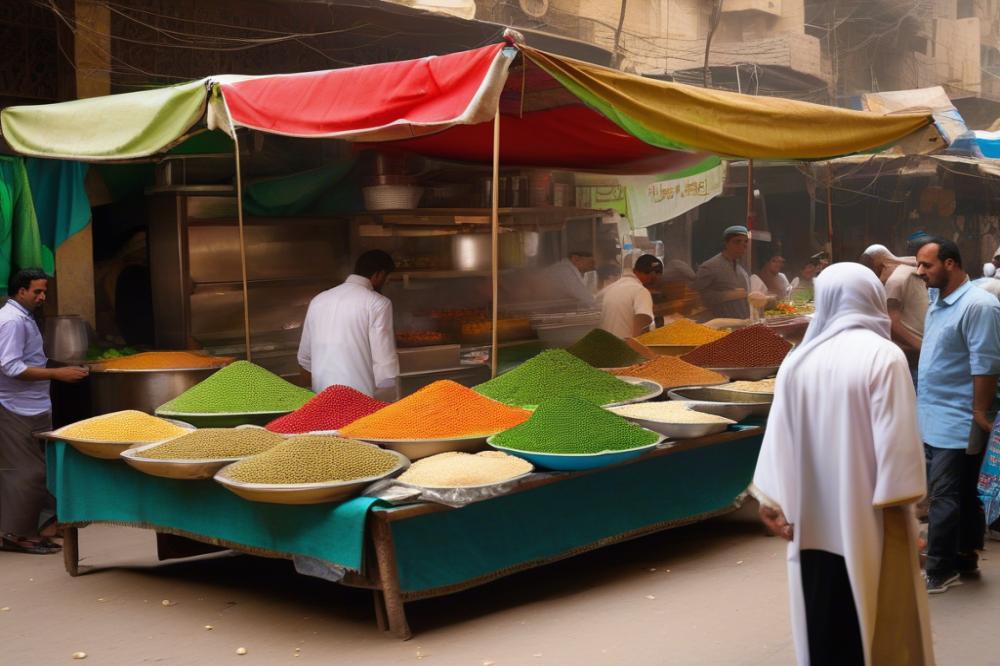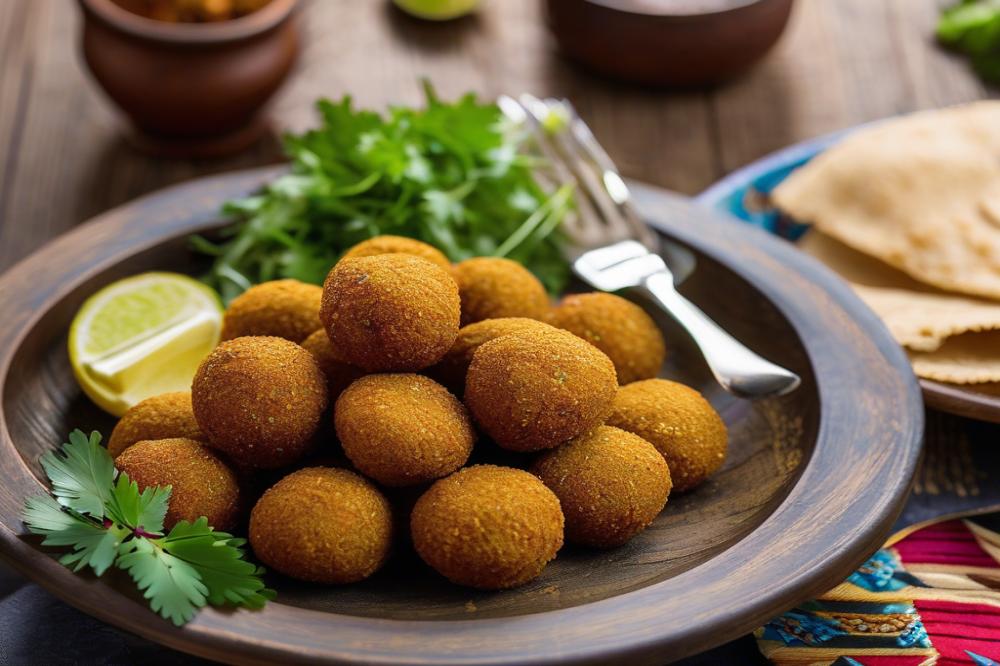Exploring the Delight of Ta’ameya: Egypt’s Own Falafel
When you think about falafel, many people envision the chickpea-based balls of goodness that are popular across the Middle East. However, Egypt offers its own twist on this beloved snack: Ta’ameya. This variation uses fava beans instead of chickpeas, creating a distinct flavor and texture that sets it apart from the traditional recipes found in other regions.
Ta’ameya holds a significant place in Egyptian cuisine. It is often found sizzling at street food stalls, where vendors prepare it fresh, serving it hot to eager customers. As a vegetarian option, it appeals to those seeking healthy snacks that are both satisfying and tasty. The crispy deep-frying gives it a golden exterior, while the inside remains soft and herbaceous, thanks to the fresh greens that are mixed into the batter.
Herbs play a crucial role in the creation of this Egyptian falafel. Ingredients like parsley and dill are blended with fava beans to produce a vibrant green color and a unique taste profile. This highlights a marked difference from the more common chickpea falafel. Each bite offers a burst of freshness, making Ta’ameya a delightful choice for anyone exploring Middle Eastern food.
Overall, this version of falafel not only represents a staple in Egyptian street food culture but also showcases the rich culinary heritage of the country. Savory, flavorful, and utterly satisfying, Ta’ameya is a must-try for anyone looking to experience authentic Egyptian tastes.
What is Ta’ameya?

Ta’ameya is a type of falafel made primarily from fava beans rather than the chickpeas commonly found in various regions. This vegetarian dish holds a special place in Middle Eastern food, particularly within Egyptian cuisine. Street vendors often serve it as a popular snack or meal, especially enjoyed for breakfast. Its vibrant flavors and crispy texture make it a beloved choice for many seeking healthy snacks.
The origins of Ta’ameya trace back to ancient Egypt. Over centuries, this dish has evolved, reflecting the cultural and culinary influences of the region. It is believed that fava beans were more accessible in Egypt than chickpeas, resulting in the unique use of fava as the base ingredient. Traditional recipes have been passed down through generations, showcasing the dish’s rich heritage.
In comparison with traditional chickpea falafel, Ta’ameya offers a different taste experience. The fava beans provide a distinct flavor profile, enhanced by an array of fresh herbs and spices. Whereas chickpea falafel is commonly found throughout the Levant and beyond, Ta’ameya remains a staple in Egypt. Both types of falafel involve deep-frying, creating a satisfying crunch, but the ingredients lead to different textures and tastes.
Ingredients List and Nutritional Information

To make a delicious batch of Egyptian falafel, you will need the following ingredients:
- 1 cup dried fava beans (soaked overnight)
- 1 small onion (chopped)
- 3 cloves garlic (minced)
- 1 cup fresh parsley (chopped)
- 1/2 cup fresh cilantro (chopped)
- 1 teaspoon cumin powder
- 1 teaspoon coriander powder
- 1 teaspoon baking soda
- Salt and pepper to taste
- Vegetable oil for deep-frying
Each ingredient brings distinct flavors and nutrients. Fava beans are rich in protein and fiber, making them a healthy base for this vegetarian dish. They contain essential vitamins like folate, which supports heart health. Fresh herbs such as parsley and cilantro add not only flavor but also antioxidants that can help protect your body from illness.
Nutritional Information
Here’s a breakdown of the nutritional aspects of the main ingredients:
- Dried fava beans: Approximately 1 cup contains about 200 calories, 14g of protein, 1g of fat, and 35g of carbohydrates. High in fiber, they help with digestion.
- Onion: A small onion contributes roughly 45 calories, with minimal fat. They provide vitamin C and beneficial compounds that may reduce inflammation.
- Garlic: The three cloves add about 13 calories. Garlic has compounds known for boosting the immune system.
- Parsley: One cup roughly has 22 calories and is high in vitamins A, C, and K. Its unique flavor enhances any dish.
- Cilantro: Half a cup comes in at around 11 calories. This herb is known for its potential detoxifying benefits.
- Cumin and coriander powder: These spices add negligible calories but come packed with flavors and possible health benefits, including digestive support.
- Baking soda: This ingredient aids in creating a fluffy texture, with no calories.
- Vegetable oil: Used for deep-frying, calories will vary based on absorption but add about 120 calories per tablespoon.
Fava beans not only provide substantial protein but also help in managing blood sugar levels. Incorporating fresh herbs in this falafel recipe enhances both taste and nutritional value. Eating this dish gives you a bite of rich, traditional Egyptian cuisine. It serves as a great street food option, making it a favored choice among many looking for tasty, healthy snacks. This recipe celebrates the essence of Middle Eastern food while being easy to prepare at home. Enjoy the process of making it, and share it with friends and family!
Method to Make Ta’ameya

To create this popular Egyptian dish, start with fava beans. These legumes are typically soaked overnight. Rinse them well before using. This step helps to soften the beans and prepares them for blending.
Next, it’s time to blend. Use a food processor for the best results. Combine the soaked fava beans with fresh herbs like parsley and cilantro. Adding garlic, onions, and spices provides a rich flavor profile. A pinch of cumin or coriander can elevate the taste. Make sure to blend everything into a smooth mixture, not too runny, aiming for a dough-like consistency.
Now, shape the mixture into patties or balls. This part can be fun! Wet your hands slightly to prevent sticking. Aim for uniform sizes to promote even cooking. These small balls reflect the essence of traditional recipes often found in Egyptian street food.
Next comes the deep-frying. Heat oil in a deep pan until it reaches the proper temperature. To test if the oil is hot enough, drop a small piece of the mixture in. It should sizzle upon contact. Fry the patties in batches, being careful not to overcrowd the pan. Turn them occasionally until they appear golden brown and crispy.
After frying, drain the falafel on paper towels. This helps remove excess oil, keeping your healthy snacks light. You can keep them warm in a low oven while you finish frying the rest.
Tips for Achieving the Perfect Texture and Flavor
When working with fava beans, freshness matters. Whenever possible, use dried beans instead of canned ones. The texture of freshly cooked fava will lead to a better result.
Blend the ingredients until smooth, but avoid over-processing. The mixture should still have a bit of texture to give the final product a nice bite. Experimenting with different herbs can also add unique flavors to your recipe; some people enjoy adding mint for an extra hint of freshness.
For frying, select a neutral oil with a high smoking point, like sunflower oil or peanut oil. Adjust the heat as needed. If the oil is too hot, the outside may brown too quickly while the inside remains raw. Taking care of your frying temperature helps achieve the desired outcome.
Lastly, serving suggestions matter. Serve your falafel with tahini sauce or yogurt along with fresh vegetables for a wholesome meal. These delights are not just food; they represent a vibrant part of Middle Eastern food culture.
Serving Suggestions and Variations

Traditional Ways to Serve Ta’ameya in Egypt
Street vendors in Egypt often showcase Ta’ameya within freshly baked pita bread. This presentation makes it a popular choice for a quick meal. Head over to any local market, and you’ll see them served in sandwich form, filled with fresh vegetables like lettuce, tomatoes, and pickles. This fun way of eating adds a crunch that many enjoy. Locals often add chili or spices for an extra kick, appealing to those who like their food with a bit of heat.
Recommended Dips and Sauces
Pairing is key when enjoying this delicious falafel recipe. A classic choice is tahini sauce, made from ground sesame seeds. Its creamy texture offers a perfect balance to the crispy exterior of the fried balls. Another popular option is garlic sauce, which packs a punch with its rich flavor. Both dips complement the dish beautifully and enhance the dining experience. Offering a mix of these dips can cater to varying tastes, from mild to strong.
Possible Side Dishes That Pair Well with Ta’ameya
When serving Ta’ameya, consider adding side dishes to create a fuller meal. Fattoush, a vibrant salad made with mixed greens and crispy pita, serves as a refreshing contrast. Alternatively, serving tabbouleh, rich in parsley and bulgur, adds brightness to the plate. For those seeking something more hearty, a side of spiced rice can also be delicious. Each of these sides complements the main dish, making for an enjoyable meal.
Variations of Ta’ameya with Different Herbs or Spices
Adjusting the herbs and spices can lead to exciting twists on traditional recipes. Common additions include cilantro and dill, each offering their unique flavors to the dish. Some creative cooks even explore adding a hint of mint, giving a fresh taste. Others might experiment with spices like cumin or coriander for a more intense flavor. Each variation can introduce a new sensation to the palate, showcasing the versatility of this vegetarian delight. Deep-frying these variations creates a crispy texture that everyone loves, while still promoting healthy snacks through plant-based ingredients.
Final Thoughts on Enjoying Egyptian Street Food
Recapping the experience of making this falafel recipe, it’s clear that the joy comes from both the preparation and the enjoyment of these delicious treats. Each step in the process brings a sense of accomplishment. Rolling the blended mixture into balls and frying them creates a unique connection to the vibrant culture of Egyptian cuisine.
Exploring these flavors can truly be a delightful adventure. As you take your first bite, the crispy exterior gives way to a warm, herb-filled center, making it hard not to smile. Sharing your creations with friends or family adds to the experience, inviting everyone to appreciate the rich culinary traditions of Egypt together.
Readers should consider incorporating this healthy dish into their meals. With its plant-based ingredients, it offers both nourishment and satisfaction. While diverse diets evolve, keeping traditional recipes alive is important. They remind us of different cultures and culinary practices.
As you experiment with this dish in your own kitchen, consider adding your personal touch. Whether through different spices or accompanying sauces, the possibilities are endless. Embracing the flavors and textures can enhance modern vegetarian diets, making every meal a celebration. Overall, enjoy the process and savor every bite.



